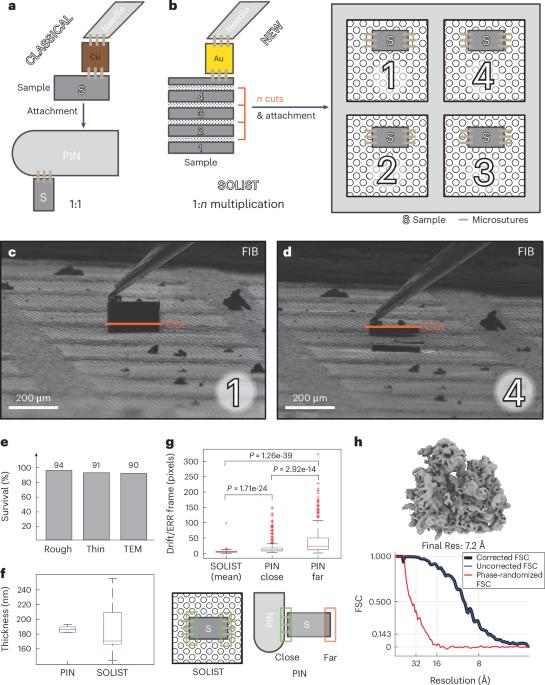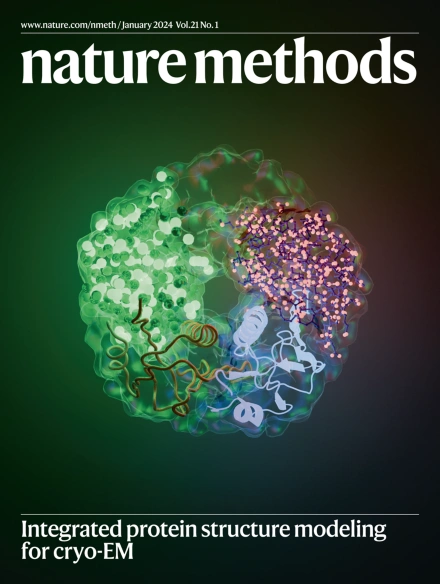Serialized on-grid lift-in sectioning for tomography (SOLIST) enables a biopsy at the nanoscale
IF 36.1
1区 生物学
Q1 BIOCHEMICAL RESEARCH METHODS
引用次数: 0
Abstract
Cryo-focused ion beam milling has substantially advanced our understanding of molecular processes by opening windows into cells. However, applying this technique to complex samples, such as tissues, has presented considerable technical challenges. Here we introduce an innovative adaptation of the cryo-lift-out technique, serialized on-grid lift-in sectioning for tomography (SOLIST), addressing these limitations. SOLIST enhances throughput, minimizes ice contamination and improves sample stability for cryo-electron tomography. It thereby facilitates the high-resolution imaging of a wide range of specimens. We illustrate these advantages on reconstituted liquid–liquid phase-separated droplets, brain organoids and native tissues from the mouse brain, liver and heart. With SOLIST, cellular processes can now be investigated at molecular resolution directly in native tissue. Furthermore, our method has a throughput high enough to render cryo-lift-out a competitive tool for structural biology. This opens new avenues for unprecedented insights into cellular function and structure in health and disease, a ‘biopsy at the nanoscale’. Serialized on-grid lift-in sectioning for tomography (SOLIST) improves the throughput of the serial lift-out technique for creating lamellas, addressing a major bottleneck in the use of cryo-electron tomography for in situ structural biology.

用于断层扫描的序列化栅上抬入切片技术(SOLIST)实现了纳米级活检
低温聚焦离子束铣削技术为我们打开了进入细胞的窗口,极大地推动了我们对分子过程的了解。然而,将这种技术应用于组织等复杂样本却面临着相当大的技术挑战。在这里,我们介绍了一种创新的冷冻抬出技术,即用于断层扫描的序列化栅上抬入切片技术(SOLIST),以解决这些局限性。SOLIST 提高了吞吐量,最大限度地减少了冰污染,并提高了低温电子断层扫描的样品稳定性。因此,它有助于对各种标本进行高分辨率成像。我们在重组液-液相分离液滴、脑器官组织以及小鼠大脑、肝脏和心脏的原生组织上展示了这些优势。有了 SOLIST,现在可以直接在原生组织中以分子分辨率研究细胞过程。此外,我们的方法具有足够高的通量,使低温跃迁成为结构生物学的竞争工具。这为前所未有地深入了解健康和疾病中的细胞功能和结构开辟了新途径,是一种 "纳米级活检"。用于断层扫描的串行栅格抬入切片技术(SOLIST)提高了用于创建薄片的串行抬出技术的吞吐量,解决了低温电子断层扫描用于原位结构生物学的一个主要瓶颈。
本文章由计算机程序翻译,如有差异,请以英文原文为准。
求助全文
约1分钟内获得全文
求助全文
来源期刊

Nature Methods
生物-生化研究方法
CiteScore
58.70
自引率
1.70%
发文量
326
审稿时长
1 months
期刊介绍:
Nature Methods is a monthly journal that focuses on publishing innovative methods and substantial enhancements to fundamental life sciences research techniques. Geared towards a diverse, interdisciplinary readership of researchers in academia and industry engaged in laboratory work, the journal offers new tools for research and emphasizes the immediate practical significance of the featured work. It publishes primary research papers and reviews recent technical and methodological advancements, with a particular interest in primary methods papers relevant to the biological and biomedical sciences. This includes methods rooted in chemistry with practical applications for studying biological problems.
 求助内容:
求助内容: 应助结果提醒方式:
应助结果提醒方式:


